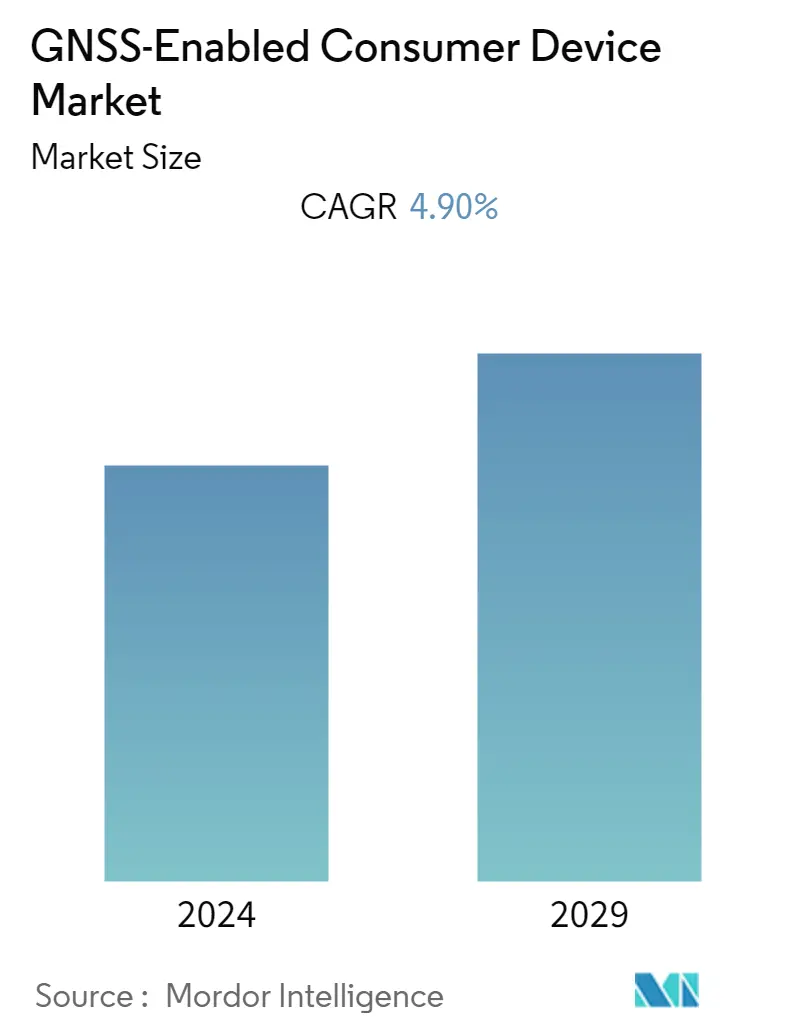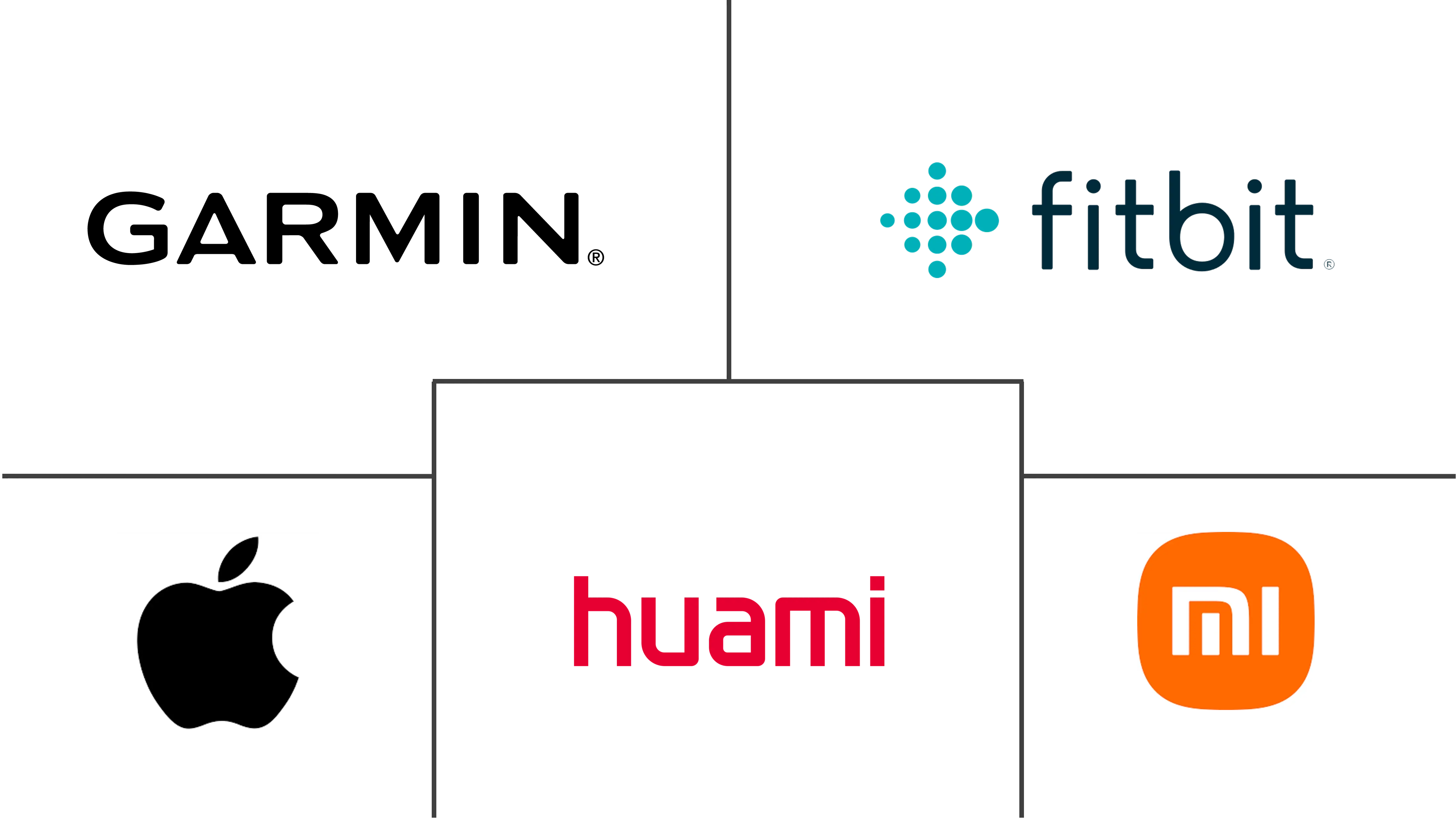Market Size of GNSS-Enabled Consumer Device Industry

| Study Period | 2019 - 2029 |
| Base Year For Estimation | 2023 |
| CAGR | 4.90 % |
| Fastest Growing Market | Asia-Pacific |
| Largest Market | North America |
| Market Concentration | Medium |
Major Players
*Disclaimer: Major Players sorted in no particular order |
GNSS-Enabled Consumer Device Market Analysis
The GNSS-Enabled Consumer Device Market is expected to register a CAGR of 4.9% during the forecast period (2022-2027). The increasing volume of consumer electronics equipped with navigation and positioning features is expected to create a considerable demand for GNSS. For instance, Cisco reported that Wearables used in North America and the Asia Pacific are together forecast to account for around 70% of the wearable 5G connections worldwide in 2022. According to Cisco, in 2021, 258.2 million connected wearable devices are expected to get a connection in the Asia-Pacific region. Over the forecast period, such growth in demand for consumer electronics is expected to retain it as the largest consumer of GNSS chips.
Escalating the Internet of Things (IoT) usage and wearable devices that use location information has increased the demand for GNSS receiver LSIs. Precise positioning and reliable communications must be ensured for the proper operation of IoT and wearable devices, which are used even in challenging communication environments and unstable conditions. Further, device size constraints necessitate a compact battery, whereas satellite signal reception and positioning when using GNSS functionality consume a lot of power, resulting in poor battery life. Therefore, various technology companies are developing and launching new products that augment the capabilities of wearable devices.
Further, the new generation of Android smartphones is equipped with high-performance Global Navigation Satellite System (GNSS) chips capable of tracking dual-frequency multi-constellation data. Moreover, starting from Android version 9, users can disable the duty cycle power saving option; thus, better quality pseudo-range and carrier phase raw data are available. Also, applying the Precise Point Positioning (PPP) algorithm has become more interesting. This work aims to assess the PPP performance of the first dual-frequency GNSS smartphone produced by Xiaomi equipped with a Broadcom BCM47755. The advantage of acquiring dual-frequency data is highlighted by comparing the performance obtained by Xiaomi with that of a single-frequency smartphone, the Samsung S8. The vertical and horizontal accuracy achieved by Xiaomi is 0.51 m and 6 m, respectively, while those achieved by Samsung are 5.64 m for 15 m for horizontal and vertical.
Small industrial asset trackers used in industrial asset tracking applications are designed for managing a large fleet of GPS-enabled asset tags to keep checks on parcels, boxes, roll cages, livestock, and across vast supply chains. These may only become viable in heavy applications if maintenance efforts, primarily focused on keeping trackers powered up, are kept to a minimum. The battery longevity can be extended considerably by using a series of hardware and firmware-based tweaks to optimize the proportion between tracking performance and power consumption. But meeting ambitious power consumption targets in low-power asset tracking and related applications can be challenging. There are many ways to integrate GNSS receivers into an end-product, some of which are more power-efficient than others.
In February 2022, Colorado-based Dronee announced that it is preparing to launch an open-source asset tracker, Loko, designed to combine GNSS support with a long-range low-power LoRa radio uplink, with up to a year of tracking per charge. A USP of the device is a long battery life, which can work for over 30 days to a year per charge of its internal battery, depending on how frequently it transmits its position.
Multiple new applications sprang up due to COVID-19, increasing the usage of GNSS chips. For instance, COVID-19 has increased the need for supply-chain assets to be transported and tracked with precision. The effective use of GNSS has been for quarantine monitoring and enforcement, where it is used to set up a virtual perimeter for those who are in self-quarantine through a process known as geofencing. In general, the location data is gathered from a smartphone or other supporting device and is utilized to inform local authorities when the self-quarantine is breached.
GNSS-Enabled Consumer Device Industry Segmentation
Global Navigation Satellite System (GNSS) is defined as the infrastructure that allows users with a compatible device to determine their position, velocity, and time by processing signals from satellites. GNSS signals are provided by a variety of satellite positioning systems, including global and regional constellations, and Satellite-Based Augmentation Systems: including Global constellations such as GPS (USA), GLONASS (Russian Federation), Galileo (EU), BeiDou (PRC); Regional constellations: QZSS (Japan), IRNSS (India), and BeiDou regional component (PRC); and Satellite-Based Augmentation Systems (SBAS).
GNSS-enabled devices find applications across consumer markets, Automotive, Aerospace & Defense, Maritime, Rail, and Agriculture, among others. For the purpose of the study, only GNSS-enabled consumer devices are considered.
The GNSS-Enabled Consumer Device Market is segmented by device type (smartphones, tablets & wearables, personal tracking devices, Low-Power asset trackers) and geography.
| By Device Type | |
| Smartphones | |
| Tablets & Wearables | |
| Personal Tracking Devices | |
| Low-Power Asset Trackers | |
| Other Device Types |
| By Geography | |
| North America | |
| Europe | |
| Asia-Pacific | |
| Latin America | |
| Middle-East and Africa |
GNSS-Enabled Consumer Device Market Size Summary
The GNSS-Enabled Consumer Device Market is poised for significant growth, driven by the increasing integration of navigation and positioning features in consumer electronics. This trend is particularly evident in the proliferation of wearables and IoT devices, which require precise positioning and reliable communication capabilities. The demand for GNSS receiver LSIs is escalating as these devices are utilized in challenging environments, necessitating advancements in technology to enhance their functionality. The market is characterized by the development of high-performance GNSS chips, such as those found in the latest Android smartphones, which support dual-frequency multi-constellation data tracking. This technological progression is further supported by regulatory measures, such as the European Commission's mandate for GNSS-enabled smartphones, which is expected to bolster the market by ensuring compatibility with satellite systems like Galileo.
Despite the saturation in mature markets, the GNSS-enabled consumer device market continues to expand, with smartphones leading the charge due to their widespread adoption of GNSS chips. These chips, while historically less accurate than dedicated navigation devices, are becoming more sophisticated, offering improved positioning capabilities. The market is moderately consolidated, with key players investing in innovation and strategic partnerships to enhance their product offerings. Recent advancements include the integration of Trimble RTX GNSS technology in mobile platforms for superior location capabilities and the development of low-power GNSS receivers to extend battery life in wearables. The market's growth is further supported by initiatives in regions like China, which emphasize R&D and the promotion of domestic GNSS systems, indicating a robust future for GNSS-enabled consumer devices globally.
GNSS-Enabled Consumer Device Market Size - Table of Contents
-
1. MARKET DYNAMICS
-
1.1 Market Drivers
-
1.1.1 Wearables and tracking devices are boosting the GNSS market, whilst smartphone shipments are maturing
-
-
1.2 Market Challenges
-
1.2.1 Complexity regarding power consumption
-
-
1.3 Market Opportunities
-
1.3.1 Emerging Applications of GNSS enabled consumer devices (Augmented Reality, Robotics, mHealth, Geo marketing and advertising, Fraud management and billing, Safety and emergency etc)
-
-
1.4 Impact of COVID-19 on the market
-
-
2. MARKET SEGMENTATION
-
2.1 By Device Type
-
2.1.1 Smartphones
-
2.1.2 Tablets & Wearables
-
2.1.3 Personal Tracking Devices
-
2.1.4 Low-Power Asset Trackers
-
2.1.5 Other Device Types
-
-
2.2 By Geography
-
2.2.1 North America
-
2.2.2 Europe
-
2.2.3 Asia-Pacific
-
2.2.4 Latin America
-
2.2.5 Middle-East and Africa
-
-
GNSS-Enabled Consumer Device Market Size FAQs
What is the current GNSS-Enabled Consumer Device Market size?
The GNSS-Enabled Consumer Device Market is projected to register a CAGR of 4.90% during the forecast period (2024-2029)
Who are the key players in GNSS-Enabled Consumer Device Market?
Apple Inc, Garmin Ltd, Fitbit (Google), Huami Corporation and Xiaomi are the major companies operating in the GNSS-Enabled Consumer Device Market.

